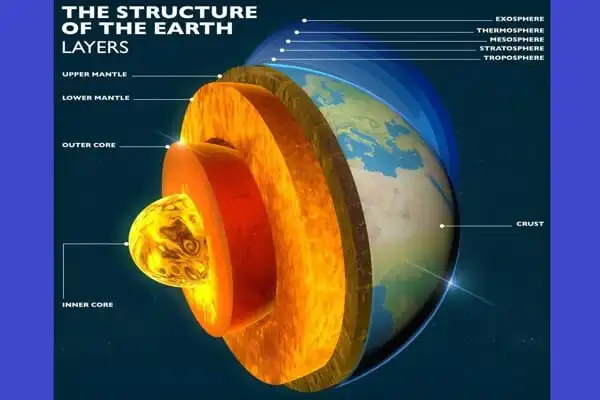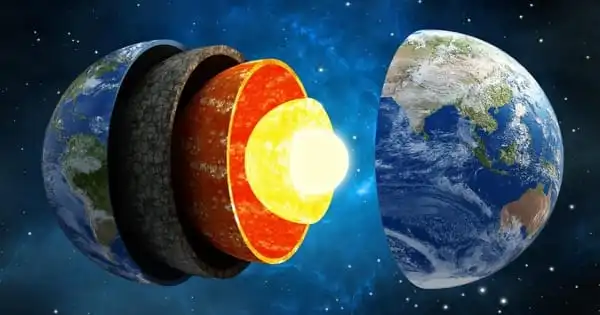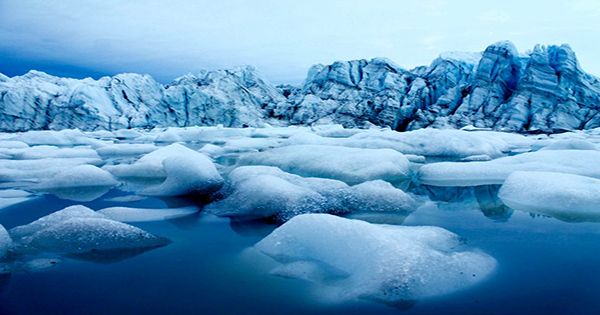The Earth’s core is cooling faster than previously thought, which might hasten the planet’s inevitable march toward uninhabitability in millions or billions of years. For the entirety of Earth’s 4.5 billion-year existence, the planet’s interior has been steadily cooling, a generally beneficial pattern as the planet evolved into its current green paradise, where people have lived for the past 200,000 years.
Researchers demonstrated in the lab how successfully a mineral found near the Earth’s core and mantle transmits heat. As a result, they believe that the Earth’s heat will disperse sooner than previously assumed.
Our planet’s evolution is the narrative of its cooling: Extreme temperatures existed on the surface of the young Earth 4.5 billion years ago, and it was covered by a deep ocean of magma. Over millions of years, the planet’s surface cooled to produce a fragile crust. However, the vast thermal energy emitted from the Earth’s interior set in motion dynamic processes such as mantle convection, plate tectonics, and volcanism.
The concerns of how fast the Earth cooled and how long it might take for this continued cooling to bring the aforementioned heat-driven processes to an end remain unanswered. One such answer could be found in the heat conductivity of the minerals that constitute the barrier between the Earth’s core and mantle.
Our findings could provide a new perspective on the evolution of Earth’s dynamics. They imply that Earth, like the other rocky planets Mercury and Mars, is cooling and becoming inactive at a much faster rate than projected.
Professor Motohiko Murakami
This boundary layer is significant because it is here that the viscous rock of the Earth’s mantle comes into direct touch with the planet’s molten iron-nickel melt. Because the temperature disparity between the two levels is so severe, there could be a lot of heat going here. The boundary layer is primarily composed of the mineral bridgmanite. However, because experimental verification is difficult, researchers are having difficulty determining how much heat this mineral transmits from the Earth’s core to the mantle.
Now, ETH Professor Motohiko Murakami and his Carnegie Institution for Science colleagues have developed a sophisticated measuring system that allows them to measure the thermal conductivity of bridgmanite in the laboratory under pressure and temperature conditions similar to those found inside the Earth. They used a freshly designed optical absorption measurement device in a diamond unit heated with a pulsed laser for the measurements.

“We were able to demonstrate that the heat conductivity of bridgmanite is approximately 1.5 times higher than assumed using this measurement system,” Murakami explains. This implies that heat transport from the core to the mantle is also greater than previously anticipated. Increased heat flow, in turn, enhances mantle convection and speeds up Earth’s cooling. This could lead plate tectonics, which is powered by mantle convective motions, to decelerate faster than experts anticipated based on prior heat conduction values.
Murakami and colleagues have also demonstrated that fast cooling of the mantle alters the stable mineral phases at the core-mantle boundary. Bridgmanite cools and transforms into the mineral post-perovskite. However, the researchers believe that after post-perovskite forms at the core-mantle border and begins to dominate, the cooling of the mantle would accelerate even faster, because this mineral transfers heat even more efficiently than bridgmanite.
“Our findings could provide a new perspective on the evolution of Earth’s dynamics. They imply that Earth, like the other rocky planets Mercury and Mars, is cooling and becoming inactive at a much faster rate than projected” Murakami elaborates.
He cannot, however, predict how long it will take for convection currents in the mantle to cease. “We still don’t know enough about these kinds of occurrences to narrow down their timing,” he says, adding that doing so necessitates a deeper knowledge of how mantle convection operates in both spatial and temporal dimensions. Furthermore, scientists must determine how the decay of radioactive materials in the Earth’s interior, which is one of the primary sources of heat, influences the dynamics of the mantle.
“The findings indicate that the mantle is more efficiently chilled, which would eventually diminish numerous tectonic events caused by mantle convection more quickly than expected from generally assumed thermal conduction behavior.”
When the planet cools, it loses its magnetic field, which protects Earth from dangerous cosmic radiation. Earth would then become a sterile, uninhabitable rock. The researchers did not speculate on how many more years life on Earth could exist.
















